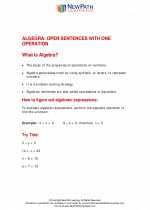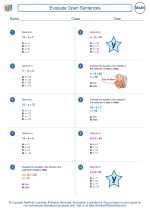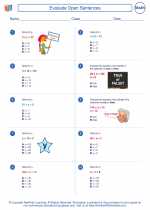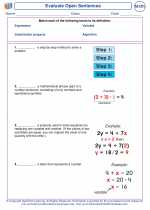Evaluating Open Sentences
An open sentence is a mathematical statement that contains variables, such as x or y, and can be either true or false depending on the value of the variables. To evaluate an open sentence, you need to substitute specific values for the variables and determine whether the statement is true or false.
Steps to Evaluate Open Sentences
- Identify the Variables: Determine which letters or symbols in the open sentence represent variables.
- Choose Values for the Variables: Select specific numbers or values to substitute for the variables in the open sentence.
- Substitute and Simplify: Replace the variables with the chosen values and simplify the expression to determine if the statement is true or false.
- Verify Your Solution: Double-check your work to ensure that the evaluation is correct.
Example:
Consider the open sentence: 2x + 5 = 15. To evaluate this open sentence, follow these steps:
- Identify the Variables: In this case, the variable is x.
- Choose Values for the Variables: Let's choose x = 5.
- Substitute and Simplify: Replace x with 5 in the open sentence: 2(5) + 5 = 15. Simplify to get 10 + 5 = 15, which simplifies to 15 = 15.
- Verify Your Solution: Since 15 equals 15, the original open sentence is true when x = 5.
Study Guide:
To effectively evaluate open sentences, it's important to practice with a variety of examples. Here are some tips for mastering this concept:
- Understand the difference between open sentences and closed sentences.
- Practice substituting different values for the variables to see how the open sentence changes.
- Use a variety of numbers and operations to create different open sentences and evaluate them.
- Check your work by plugging the values back into the original open sentence to ensure it evaluates to true or false.
By following these steps and tips, you'll become proficient in evaluating open sentences and gain a deeper understanding of how variables affect mathematical statements.
[Evaluate Open Sentences] Related Worksheets and Study Guides:
.◂Math Worksheets and Study Guides Fourth Grade. Evaluate Open Sentences
Study Guide Evaluate Open Sentences
Evaluate Open Sentences  Worksheet/Answer key
Worksheet/Answer key Evaluate Open Sentences
Evaluate Open Sentences  Worksheet/Answer key
Worksheet/Answer key Evaluate Open Sentences
Evaluate Open Sentences  Worksheet/Answer key
Worksheet/Answer key Evaluate Open Sentences
Evaluate Open Sentences  Vocabulary/Answer key
Vocabulary/Answer key Evaluate Open Sentences
Evaluate Open Sentences 

 Worksheet/Answer key
Worksheet/Answer key
 Worksheet/Answer key
Worksheet/Answer key
 Worksheet/Answer key
Worksheet/Answer key
 Vocabulary/Answer key
Vocabulary/Answer key

The resources above cover the following skills:
Algebra (NCTM)
Represent and analyze mathematical situations and structures using algebraic symbols.
Express mathematical relationships using equations.
Use mathematical models to represent and understand quantitative relationships.
Model problem situations with objects and use representations such as graphs, tables, and equations to draw conclusions.